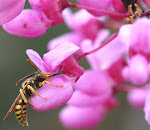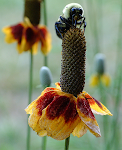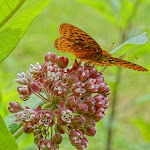Monday, April 19, 2010
The joy and the pain of beekeeping
The answer is mixed: one hive, the blue one, is doing splendidly. Lots of honey from last season, lots of brood, lots of workers. I had checked in three weeks ago, before leaving on a big trip, and came home intending to reverse all the hive boxes (swapping bottom with top boxes keeps a production chain going by putting the empty frames back on top for Queen Elizabeth to fill). This I did.
My only concern about Elizabeth was she has more than the usual number of drone cells. Not so many that I think workers are laying (i.e. no queen present), but more than the usual distribution. I seem to remember that last year, prior to swarming, there were a lot of drone cells. Maybe Eliz was feeling crowded and the wheels are now in motion. This time around I'd like to split her hive if it comes to it, capturing bees before they leave. Also I might need to because I fear I am losing my second hive...
The green hive, Kathryn's, I was worried about last fall. She had a heavy varroa mite infestation and I'd seen crippled wing disease. Her worker numbers were WAY down after the winter. Three weeks ago I had given her a frame of Elizabeth's brood, hoping to boost numbers.
However, when I opened her up yesterday I saw: very small amount of brood, a spotty brood pattern, holes in some of the brood caps, and dead rotting larvae inside cells. All of this sounds like Foulbrood, a perfectly horrible disease that not only kills off the hive, but requires the keeper to burn everything because the disease is spread by spores which contaminate the hive boxes and frames.
See what I mean about the pain of beekeeping? I've put a call out to my beekeeping mentors to confirm the diagnosis.
*Sigh*. Such a bummer.
Wednesday, October 28, 2009
Corn Syrup linked to bee colony collapse
Government researchers have found that high-fructose corn syrup, which is used as a sweetening agent in thousands of products, creates potentially dangerous levels of a toxic substance when heated.
The scientists – from USDA’s Agricultural Research Service in Tuscon and New Orleans and at the University of Wisconsin – were searching for a possible cause of Colony Collapse Disorder, a mysterious disease that has killed at least one-third of the nation’s commercial bees.
The team targeted the popular sweetener because it is widely used both with honey bees and those used primarily for vital crop pollination.
High-fructose corn syrup is produced by grinding corn to produce corn starch, then that powder is processed to yield corn syrup, which is almost entirely glucose. Enzymes or proteins are then added which changes the glucose into fructose.
It is the fructose that food producers use to sweeten their products and by commercial beekeepers to strengthen their bees, to increase honey production and as a food supplement when natural sources of nectar and pollen have diminished.
During repeated tests, the researchers found that when the HFCS is heated it forms hydroxymethylfurfural or HMF which can kill honeybees. Alarmingly, they found when temperatures rose, levels of HMF increased steadily in proportion.
The study, by Blaise LeBlanc, Gillian Eggleston and their colleagues, is published this week in ACS’ Journal of Agricultural and Food Chemistry. The authors said their work could also help keep the substance out of soft drinks and dozens of other human foods that contain HFCS.
“The data are important for commercial beekeepers . . . and because HFCS is incorporated as a sweetener in many processed foods, the data from this study are important for human health as well,” states the report which was funded by the National Honey Board.
Laboratory studies in Sweden published this year have linked HMF to DNA damage in humans, the USDA team reported. In addition, HMF breaks down in the body to other substances – daughter metabolites – potentially more harmful than the original substance.
For close to a decade, researchers throughout the world have been searching for the cause of the widespread destruction of bee colonies.
In the U.S., the growing shortage of honey has caused the increased importation of foreign products, much of which is wrongly labeled to avoid paying tariffs on Chinese honey. Some are adulterated with illegal antibiotics on violation of FDA regulations.
Here is a link to the study published by the ACS.
Wednesday, July 15, 2009
Managing Pests (I wish this worked on people)
Shared via AddThis
Colony Collapse Disorder is a huge concern in the world of beekeepers, farmers - and anyone who likes to eat. One third of our food crops are pollinated by, and thus dependent on, pollinators - honeybees included. All pollinators are declining in number, due to a host of things that people are doing (I could go into this at length but let's save this for a day when i am really cranky).
Honey bees in the past five years have begun to just vanish - something called Colony Collapse Disorder. The whole hive just disappears, no bodies on the ground, just all gone. And the experts are not sure why (though US EPA has recently (finally!) followed the EU in fingering pesticides as a big part of the problem).
Bees are stressed by chemicals used in agriculture, in home gardens, and in beekeeping itself. A common bane in the hive is the varroa mite - a nasty little flea-like thing that attaches itself to bees and their larvae and paracitizes them. Using miticides in hives to eliminate the mites contaminates the honey and is unhealthy for bees. It also builds up in beeswax such that now the commercially available beekeeping equipment, i.e. foundation, often contains traces of miticides. So even if you are trying to be an organic beekeeper the chemicals are present. I hate this.
There are efforts underway to manage mites using Integrated Pest Management approaches. One thing everyone around here does is use a screened bottom board so when the mites fall off the bees they fall down out of the hive and can't climb back in.
Thyme essential oil is known to repel the mites and there are other other plant-based techniques. Sprinkling frames with powered sugar causes the bees to groom extra hard and pull off mites. I haven't done any of these things yet, but these and the trap discussed in the attached article are good to know about.





